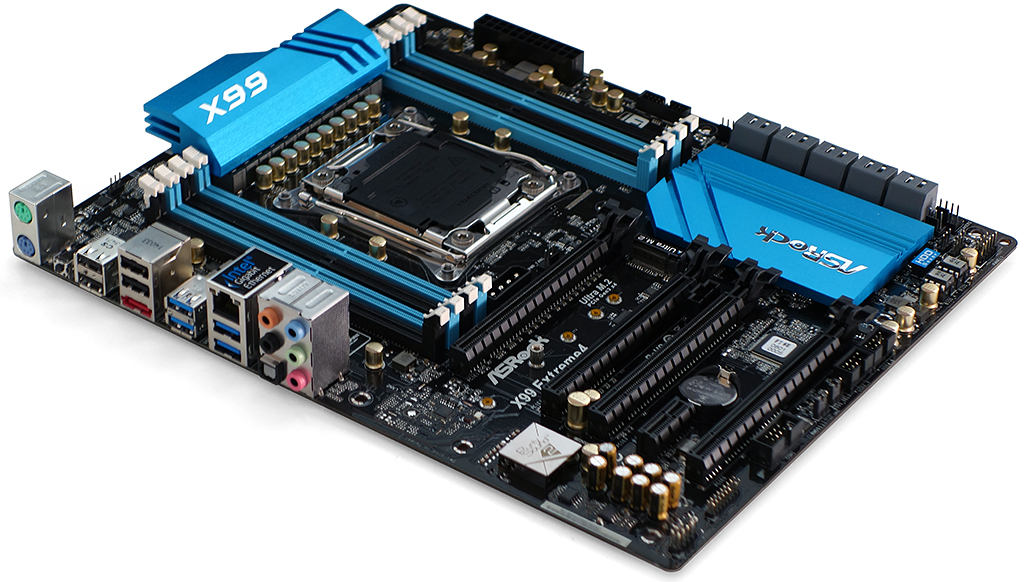Three-Way X99 LGA 2011-v3 ATX Motherboard Shootout
Buyers of Intel's X99 platform, which supports Intel's Haswell-E and new DDR4 memory, were probably prepared to pay a premium for mid-market boards. Are any of these $240 to $300 models worthy of Intel’s latest CPUs?
ASRock X99 Extreme4
The least-expensive of today’s contenders, ASRock leans exclusively on chipset features to provide four I/O panel and two front-panel USB 3.0 ports, along with a slew of USB 2.0 ports spread across internal and external connectors, in addition to 10 SATA 6Gb/s ports shared with M.2 and eSATA.
A CLR_CMOS button on the I/O panel is handy for overclockers, as are the two socket-mounted firmware ROMs along the X99 Extreme4’s bottom edge. Thanks to a selector switch, users who really screw up their firmware can switch, reboot, switch again, and hot-flash the other chip without the risk of removing components on a powered-up system. And if you somehow kill both parts, the sockets allow you to replace them with pre-programmed ICs. Any of those advanced techniques are “at your own risk” operations best left to the most experienced hands.
You’ve probably noticed that the X99 Extreme4 has four PCIe x16 slots, but that one of these wasn’t mentioned in the introduction. That’s because the second PCIe x16 slot wired as a two-lane PCIe 2.0 link to the motherboard’s PCH. An included three-way SLI bridge bypasses it entirely to connect the first, third, and fourth x16-length slots, since those are the X99 Extreme4’s only SLI-compliant interfaces.
You probably also noticed that Ultra M.2 connector located between the first and second x16-length slots. It supports PCIe 3.0 x4 by robbing the bottom slot of four lanes when you drop in a PCIe-based M.2 SSD. ASRock disables the expansion slot whenever PCIe is enabled over the M.2 interface, knocking the X99 Extreme4 down to two-way SLI or CrossFire support.
Do you want M.2 and three-way SLI? Communication through SATA is also an option for the X99 Extreme4’s M.2 interface. But ASRock only powers the slot using a single 6 Gb/s port, which is shared with the third standard SATA connector so that only one can be used at a time. The eSATA port is similarly shared with the second internal SATA port.
Other three-way SLI exclusions include the use of a 28-lane (Core i7-5820K) CPU. The reduced lane count drops board’s slots to x16/x8/x4 (as opposed to its full x16/x16/x8 configuration), and Nvidia requires at least eight lanes for each card in an SLI array. AMD’s not as fussy, so you’re still able to use three Radeons in CrossFire with your lower-cost CPU.
ASRock knows a good layout, placing its first and third x16-length interfaces with triple-slot spacing to allow extra-large graphics coolers in concert with two-way SLI or CrossFire. And since the third slot is also SLI-capable (whenever you’re not using a PCIe M.2 card), ASRock makes sure that all of the headers along the board’s edge support crush-friendly cables. USB 3.0 is the one cabled interface that can't be bent over, so ASRock puts a header along the X99 Extreme4’s front edge, just above the board’s center line.
Get Tom's Hardware's best news and in-depth reviews, straight to your inbox.
Looking harder for layout problems, we find only that the front-panel audio connector is placed in the bottom-rear corner, where Intel thinks it should be. The reason that’s a potential problem is that the cables of some cases are around ½” too short to reach the corner.
We’d have also liked to see an extra fan header near the top edge, since many cases have a pair of top-mounted fans.
Are you still having trouble thinking of any DDR4-supporting three-way SLI motherboard as being mainstream? Then take a look at the X99 Extreme4’s cable kit, which only includes four SATA cables to serve its 10 SATA headers. At least ASRock was kind enough to include a two-drive power cable to connect its HDD Saver power-control software.
Current page: ASRock X99 Extreme4
Prev Page More, Less Or Just Different? Next Page ASRock X99 Extreme4 Software-
west7 In the 3D gaming page it should been i7-5760x not i7-4790 and fix the LGA 2111-v3 typo and why there in no SLI/crossfire test?!Reply -
Daniel Ladishew Can't wait for them to review some of the other manufacturer's products in the X99 category. The ASUS board especially.Reply -
chiefpiggy Noob question: would my socket 1150 i5 4670k work with one of these motherboards or do I need one of the Haswell-E processors?Reply -
sportfreak23 Reply14199415 said:Can't wait for them to review some of the other manufacturer's products in the X99 category. The ASUS board especially.
+1 -
InvalidError Reply
LGA 2011 uses DDR3 while LGA2011-3 uses DDR4 so the sockets are different to prevent people from putting the wrong CPU in the wrong motherboard.14199118 said:"LGA 2111-v3"??
Did something change?
I think there were other changes but this is the big obvious one. -
firefoxx04 it should be mentioned (and maybe it was, just not on the first page) that you only get the 40 pci e lanes if you purchase the two higher tiered haswell-E chips. The lowest end model does not support 40 lanes, I think it supports 28.Reply -
vincevdc The MB grid on page one shows that the MSI X99S Gaming 7 mb has an Intel Z97 Express chipset. This is a typo...Reply



